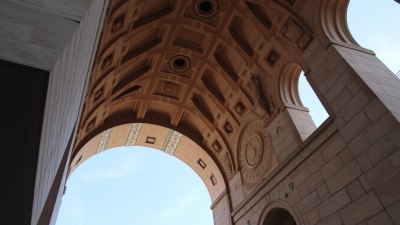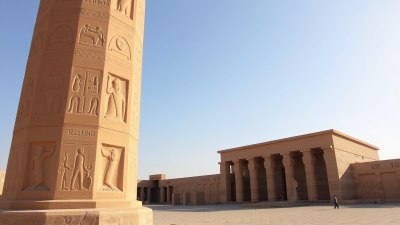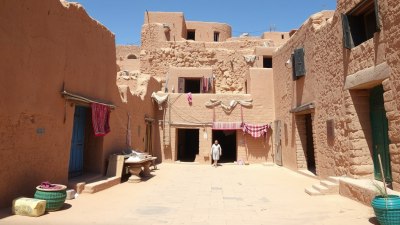When the Architecture Remembers More Than the People
Exploring the deep connection between architecture and collective memory.

Image created with Flux Schnell
Architecture serves as a silent witness to history, culture, and identity. Often, it embodies memories and narratives that outlast the individuals who once inhabited the spaces it defines. The idea that architecture remembers more than the people who inhabit it reflects a profound relationship between built environments and collective human experiences. This article delves into how structures become repositories of memories, emotions, and historical significance, often echoing the stories of those who have come before, while sometimes also becoming a canvas for contemporary narratives.
Throughout history, humans have erected buildings that serve both functional and symbolic purposes. From the ancient pyramids of Egypt to the grand cathedrals of Europe, architecture has played a crucial role in shaping societal identity. These structures stand as testimonies to technological advancements, artistic endeavors, and the cultural values of their time. They outlive individual memories, creating a tapestry of collective experience that transcends generations.
The Role of Memory in Architecture
Memory is intimately tied to the experience of places we inhabit. Architectural spaces can trigger recollections of personal and communal histories. For instance, a childhood home may evoke a flood of memories tied to family life, but it’s the broader context of the neighborhood and the architectural style that also contributes to those memories. Architecture thus becomes a vessel of memory, holding stories and experiences within its walls.
The psychology behind this phenomenon is complex. Environments shape our emotions and behaviors while simultaneously influencing how we remember specific events. For instance, the design of a public building can inspire feelings of safety and community or, conversely, foster a sense of alienation. Furthermore, as urban landscapes transform over time, the meanings we ascribe to these spaces shift, reflecting changing cultural narratives and personal memories.
Examples of Architecture as Memory
Consider the Berlin Wall, an architectural structure that split a city and a nation for decades. Today, remnants of the wall serve as powerful symbols of division, resilience, and unity. They remind us of the people who lived through the oppressive regime and the struggle for freedom. Through its physical presence, the wall encapsulates the uncertainties and hopes of an era while prompting collective remembrance. This dual nature—both a physical barrier and a symbol of liberation—illustrates how architecture can embody complex narratives that outlast individual experiences.
Similarly, monuments dedicated to historical figures or significant events serve as focal points for collective memory. The Lincoln Memorial in Washington, D.C., stands not only as an architectural marvel but also as a site of reflection on the values of democracy, freedom, and equality. Visitors are compelled to confront the complex legacy of Abraham Lincoln and the ongoing struggle for civil rights in the United States. These memorials allow architecture to hold cultural significance that shapes historical discourse long after the individuals they honor have passed.
Architectural Preservation and Memory
The preservation of historical architecture also speaks to the importance of memory in built environments. Many societies prioritize the conservation of structures that are emblematic of their heritage, ensuring that future generations can engage with their past. Preservation efforts often involve significant investment in resources and community involvement and reflect a commitment to remembering and honoring shared histories.
Consider the preservation of UNESCO World Heritage Sites, which symbolize the cultural diversity and richness of the human experience. Sites like the Acropolis in Greece or the Great Wall of China not only represent remarkable engineering and artistic achievements but also serve as reminders of the civilizations that created them. In their preservation, these structures become living reminders of human ingenuity and resilience, allowing us to interpret and understand the past collectively.
Contemporary Architecture and Memory
As we navigate modernity, the architecture of today continues to grapple with themes of memory. New structures often attempt to engage with the histories of their locations, whether through design elements that reference the past or by fulfilling social responsibilities that connect to the community. For instance, contemporary museums aim to tell the stories of marginalized groups, ensuring that their histories are neither forgotten nor overlooked.
The design of memorials to victims of tragedy—a recent example being the 9/11 Memorial in New York City—embodies the struggle to reconcile loss with remembrance. Here, architecture becomes a means of healing, creating a space for reflection, unity, and ongoing dialogue about the events that transpired. Such structures remind us of the narratives that shape our contemporary existence while honoring the memories of those who have been lost.
Architecture as a Collective Narrative
Architecture is not merely about physical structures; it encompasses the narratives and memories that are woven into the fabric of society. As we interact with our environments, we collectively co-author the stories that these structures tell. Urban redevelopment, for example, often involves retracing steps of memory by incorporating elements of the past into the new. Communities, through their engagement, can emphasize the importance of continuity and recognition, strengthening their bond with places.
Architecture also plays a role in addressing social issues, such as displacement and gentrification. The architecture of a neighborhood can shape the identities of its residents, framing their memories and lived experiences. However, as cities grow and change, the risk exists that historical narratives may be overshadowed by new developments. Balancing innovation with memory preservation becomes crucial, ensuring that the voice of the collective remains present within the evolution of urban landscapes.
Ultimately, the profound connection between architecture and memory reveals how built environments shape our understanding of identity, history, and culture. Architecture remembers more than the individuals who inhabit it; it exists as a canvas for collective memory that transcends time. Whether it is through the preservation of historical sites or the creation of new structures infused with meaning, architecture continues to play a vital role in our relationship with memory. By engaging with these spaces and the memories they evoke, we can foster a deeper understanding of our past and a more mindful approach to the future, ensuring that the stories of all those who have come before us are never forgotten.











